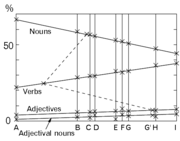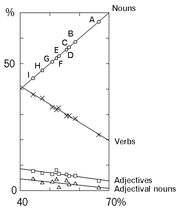
Ono's lexical law
Encyclopedia
Ōno's lexical law, or simply Ōno's law, is a statistical law for the rate word classes
as they appear in the lexicon of classical Japanese
literary works. The law was discovered by Japanese
linguist Susumu Ōno
and published in 1956.
The horizontal axis (in Ōno's formulation) is arbitrary, and should not be interpreted as time. The graph in the re-formulation by Mizutani is more easily interpreted, and shows a scatter plot of nouns versus other word classes.
 Obtain the rates of usage for four word classes: nouns, verbs, adjectives, and adjectival noun for Man'yōshū and Genji Monogatari
Obtain the rates of usage for four word classes: nouns, verbs, adjectives, and adjectival noun for Man'yōshū and Genji Monogatari
. Plot the rates of the four word classes for the Man'yōshū on the y-axis. Then plot the rates for Genji Monogatari on a vertical line to the right. Connecting the two points for the noun revealed a monotonically decreasing line, Connecting the two points for any of other word classes all resulted in a monotonically increasing line. Plot an additional point corresponding to any of other seven classic literatures on each line of the word classes. Then it revealed that any of those new point sets for one of the additional literatures on different lines of word classes was located approximately on a different vertical line.
 Let the rates of noun usage in the lexicon of 3 arbitrary literary works A, B, and C be
Let the rates of noun usage in the lexicon of 3 arbitrary literary works A, B, and C be
 , respectively. With rates
, respectively. With rates  for usage of another word class of the same 3 literatures, respectively, then 3 points,
for usage of another word class of the same 3 literatures, respectively, then 3 points,  will approximately be located on a line. Namely,
will approximately be located on a line. Namely,
Lexical category
In grammar, a part of speech is a linguistic category of words , which is generally defined by the syntactic or morphological behaviour of the lexical item in question. Common linguistic categories include noun and verb, among others...
as they appear in the lexicon of classical Japanese
Japanese language
is a language spoken by over 130 million people in Japan and in Japanese emigrant communities. It is a member of the Japonic language family, which has a number of proposed relationships with other languages, none of which has gained wide acceptance among historical linguists .Japanese is an...
literary works. The law was discovered by Japanese
Japan
Japan is an island nation in East Asia. Located in the Pacific Ocean, it lies to the east of the Sea of Japan, China, North Korea, South Korea and Russia, stretching from the Sea of Okhotsk in the north to the East China Sea and Taiwan in the south...
linguist Susumu Ōno
Susumu Ono
was a Tokyo-born linguist, specializing in the early history of the Japanese language Kokugogaku. He graduated from the University of Tokyo in 1943, where he studied under Shinkichi Hashimoto...
and published in 1956.
Summary
The law states that, for the nine literary works under consideration (one work is in two editions, hence ten manuscripts total), the percentage of words in each of the four given word classes vary simultaneously linearly, between the most noun-heavy Man'yōshū and the most verb-heavy Tale of Genji. The four word classes are nouns, verbs, adjectives, and adjectival nouns, with nouns and verbs being the bulk of the words. If there were only two word classes, this statement would be trivial: as one word class (say, nouns) decreases, the other (say, verbs) increases by exactly the corresponding amount. However, what the law observes is that as use of nouns decreases, use of verbs and adjectives and adjectival nouns increases, and that these increase by approximately constant proportions (hence linear).The horizontal axis (in Ōno's formulation) is arbitrary, and should not be interpreted as time. The graph in the re-formulation by Mizutani is more easily interpreted, and shows a scatter plot of nouns versus other word classes.
Ōno's lexical law (Original version)

The Tale of Genji
is a classic work of Japanese literature attributed to the Japanese noblewoman Murasaki Shikibu in the early 11th century, around the peak of the Heian period. It is sometimes called the world's first novel, the first modern novel, the first psychological novel or the first novel still to be...
. Plot the rates of the four word classes for the Man'yōshū on the y-axis. Then plot the rates for Genji Monogatari on a vertical line to the right. Connecting the two points for the noun revealed a monotonically decreasing line, Connecting the two points for any of other word classes all resulted in a monotonically increasing line. Plot an additional point corresponding to any of other seven classic literatures on each line of the word classes. Then it revealed that any of those new point sets for one of the additional literatures on different lines of word classes was located approximately on a different vertical line.
| Symbols | Literatures |
|---|---|
| A | Man'yōshū |
| B | Tsurezuregusa Tsurezuregusa is a collection of Japanese essays written by the monk Yoshida Kenkō between 1330 and 1332. The work is widely considered a gem of medieval Japanese literature and one of the three representative works of the zuihitsu genre, along with Makura no Sōshi and the Hōjōki.Tsurezuregusa comprises a... |
| C | Hōjōki Hojoki , variously translated as "An Account of My Hut" or "The Ten Foot Square Hut", is an important short work of the Kamakura period in Japan by Kamo no Chōmei. Written in 1212, it describes disasters that befall the people of Kyoto from earthquakes to famine and fire... |
| D | Makura no sōshi The Pillow Book is a book of observations and musings recorded by Sei Shōnagon during her time as court lady to Empress Consort Teishi during the 990s and early 11th century in Heian Japan. The book was completed in the year 1002.... |
| E | Tosa nikki |
| F | Murasaki Shikibu Nikki The Murasaki Shikibu Diary The Diary of Lady Murasaki records the daily life of the Heian era lady-in-waiting and writer, Lady Murasaki Shikibu, author of The Tale of Genji... |
| G | Sanuki no Suke Nikki |
| G' | Sanuki no Suke Nikki (earlier data before revision) |
| H | Taketori monogatari The Tale of the Bamboo Cutter , also known as , is a 10th century Japanese folktale. It is considered the oldest extant Japanese narrative and an early example of proto-science fiction.... |
| I | Genji Monogatari |
Revised Ōno's lexical law by Mizutani

 , respectively. With rates
, respectively. With rates  for usage of another word class of the same 3 literatures, respectively, then 3 points,
for usage of another word class of the same 3 literatures, respectively, then 3 points,  will approximately be located on a line. Namely,
will approximately be located on a line. Namely,  . . |

